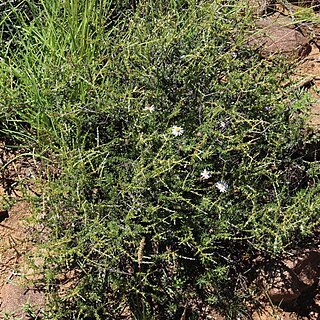Robust, many-stemmed, sympodially branched, spinescent shrubs, 0.5-1.2 m high and in diameter. Old stems displaying anomalous secondary growth, grey to dark grey; young shoots light yellow-brown, shortly sericeous, glabrescent, glandular; older branchlets grey, glabrous. Leaves opposite on dolichoblasts, decussate and densely imbricate on brachyblasts, linear, 2.5-3.5(-5.0) x 0.6-0.8 mm, entire, permanently densely silver-sericeous, adaxially flattened, slightly concave towards base, abaxially convex, slightly keeled distally, apex acute. Capitula heterogamous disciform, solitary, terminal on brachyblasts, 4.5-5.2 mm long, sessile or peduncles 1.0-3.5(-5.0) mm long, densely appressed silver-sericeous. Involucral bracts 4, oblong-ovate to almost ovate, 4.3 x 2 mm, apex acute, fringed, 2 slightly keeled, other 2 slightly flattened, central part herbaceous, green with purple margin; transparent membranous margin absent or very narrow. Paleae: those of marginal florets free, lanceolate, up to 4.5 mm long, margins long-pilose, enveloping floret totally, abaxially long-pilose, hairs septate, membranous; those of disc florets lanceolate to oblong, 2-4 x 1-2 mm, membranous, apex acute, margin and abaxially long-pilose. Marginal female florets 2, cream-coloured to yellow; corolla tube 5 mm long; lamina cuneate, 3-lobed, up to 2.2 mm long, relatively inconspicuous. Style branches flattened, apices acute, 2.5 mm long. Ovary (and cypsela) oblong, slightly flattened, long-pilose. Seed 2-3 mm long, oblanceolate, slightly flattened. Disc florets 6-8, functionally male with sterile ovary, 5 mm long; corolla tubular, widening upwards, 5-lobed, tubular part yellow with red-purple margins. Style unbranched, truncate, apex globose, with sweeping hairs. Stamens 5, exserted at maturity. Receptacle after anthesis with abundant white or brown hairs between involucral bracts and marginal paleae. Flowering time: varying from June to October or January to March depending on time of rainfall.
More
Shrub, 0.5-1.2 m high; spinescent, much branched. Leaves opposite on long shoots, decussate and imbricate on short shoots; blade linear, margins entire, permanently densely silver-sericeous. Heads disciform, sessile or very shortly pedunculate, solitary, terminal. Involucral bracts 4, oblong-ovate or ovate, green with purple margins, fringed. Receptacle with paleae of marginal florets free. Flowers: marginal female florets 2, cream-coloured to yellow; disc florets 6-8, trumpet-shaped, yellow with red-purple margins; Oct. Fruit with cypsela oblong, slightly flattened, long hairy. Pappus absent.

